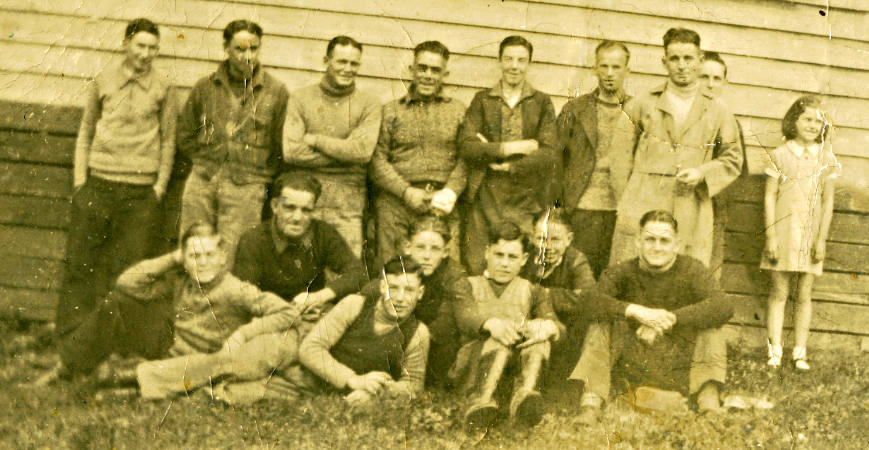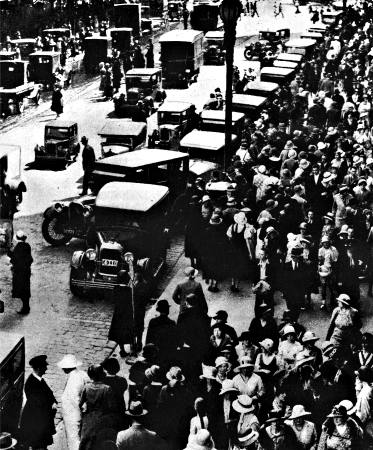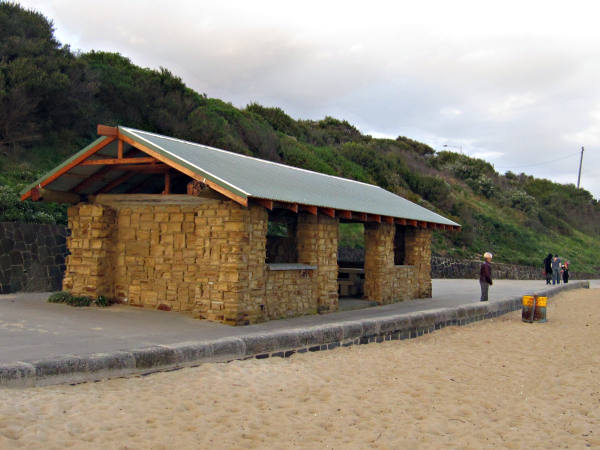Sustenance in the 1930s

Strappers from the stables of Jack Holt, Besendo and Des McCormick during the days of the Depression visit 17 Collicott Street, Mordialloc. Courtesy Chilla Dow.
Unemployment affected many families living in the municipalities of Moorabbin, Mordialloc and Chelsea in the 1920s and despite the efforts of government and councils, it accelerated further in the following decade. The stock market crash in New York on 29 October 1929, known as Black Tuesday, had repercussions around the world. After the crash, unemployment in Australia more than doubled to twenty one per cent in mid-1930, reaching a peak in mid 1932 when almost thirty two per cent of the Australian workforce were out of work. While causes are still debated amongst economists several factors are commonly discussed – fall in export prices and sales, fall in overseas loans leading to a reduction in government spending and fall in residential construction. [1] At the time privately owned banks controlled Australia’s monetary policy and the country relied heavily on borrowing money from other countries to bring in new investment.
To relieve the distress caused by unemployment the Victorian Parliament passed several acts in the1930s authorising certain actions. [2] A sustenance scheme was established for the relief of individuals able and willing to work but unable to find employment. A central Unemployment Relief Works Board (1931) was formed to allocate money from the Unemployment Relief Fund (This board was later replaced by the Employment Council of Victoria 1932) and relief committees were created throughout Victoria. These local committees made up of volunteers generally comprised Council representatives, members of Benevolent Societies and other district charitable organizations.
Through this organizational structure sustenance payments were made on the basis of 8s 6d per week for man and wife with an additional 1s 6d per week for each additional child up to a maximum of 20s 6d per week. In addition each approved individual was provided with an identification card which enabled him to gain groceries, meat, bread and milk for a four week period through nominated shopkeepers selected by the individual. [3] Sustenance also included the provision of babies’ food, clothing and footwear for school children, firewood and rental assistance.

Food handout in another era. A time of struggle for many families in 1890s.
Money was given to municipal councils willing to undertake relief work. This money was provided on the basis of £2 for £1 or £ for £ depending on the nature of the project. These subsidies by the government were for labour costs only and were for work that would not have been part of the normal council program. To finance this and other initiatives money was raised through a tax on incomes and stamp duty on wages.
At Chelsea the Public Works Committee listed work to be carried out under the sustenance program and authorized the City Engineer to proceed with as many projects as possible. They were:
- Planting marram grass and works on the foreshore reserve.
- Thinning and cleaning out ti-tree etc. in places under the Council’s control.
- Repainting fire plugs if the fire brigades provided the paint necessary for the work.
- Trimming earthen banks and water tables of Point Nepean Road.
- Cleaning grass and weeds from streets and paths in the municipality.
- Erection of bush fences.
- Straightening the edges of Point Nepean Road.
- Concreting drain through Regents Park.
In addition to the above list the committee recommended to Council that the following works be carried out by men in return for sustenance:
- Formation of a six foot pathway from Point Nepean Road to the foreshore along the northern side of the Patterson River.
- Necessary work on the municipality’s reserves.
- Repainting street name plates where necessary.
- Repair and resealing the running track in the Chelsea Reserve if material available.
Along with praise for the government’s attempts to grapple with the problems of unemployment there were also complaints and criticisms. Major complaints were the lack of sufficient money, constraints placed on councils on how the money was used, and poor allocation of money that was available. The Municipal Association in writing to the Secretary of the Public Works Department pointed out that grants in 1930 had been spent on works that were either unnecessary or could have been postponed. It argued that money raised for unemployment relief should be expended on urgent and necessary works which were of the greatest value to the community. The policy that government money should only be spent on labour placed great strain on the municipalities for they had to find their share of labour costs while in addition meeting equipment, materials and supervision costs. In practice this meant the cost of works was anything from 30/- to £3 for each £ contributed from the Unemployment Relief Fund. The secretary of the Municipal Association reminded the officers of the Public Works Department that municipalities had little scope to raise money after the State and Commonwealth extracted their money from taxation. He pointed out that local councils raised their money through rates on property values and not on an individual’s capacity to pay. [4] In the Shire of Moorabbin in 1930 many individuals were unable to pay their rates and as a consequence £8000 was in arrears. [5]
Cr Blanche of Mordialloc, at a Council meeting, said they wanted to support the government in finding work for the unemployed. He stressed the unemployed wanted work not charity. His council had taken advantage of the £ for £ scheme and had spent £4500 and of that money £900 had been spent on cleaning up the foreshore. Men had been given rakes, saws and matches to set fire to rubbish, he said, but his council considered this money had been practically thrown away. Earlier Cr White suggested that government money could be more profitably allocated to public bodies such as the Melbourne and Metropolitan Board of Works, Country Roads Board, State Rivers and Water Supply Commission. Cr Blanche said it was known that the Melbourne and Metropolitan Board of Works was anxious to undertake a large drainage scheme, which would drain a portion of the Moorabbin Shire and the City of Mordialloc. Plans were ready and the council had been told the work would commence early that year, but the Board had been held up owing to its inability to secure the necessary money. [6]
A deputation from the Municipal Association, which included Cr Blanche, put these views to the Minister of Public Works, the Hon John Jones MLC. Jones said the suggestions appealed to him and he would take them to Cabinet. While he admitted mistakes had been made in the spending of funds he said the government had been forced to act hurriedly [7].
In 1931 there were 472 men in the Shire of Moorabbin receiving sustenance in a situation where there was not sufficient work for all. Mr McGee, the secretary of the Moorabbin Shire Unemployed Association, argued that as his organisation was the only one officially recognized as representative of the unemployed, all money available should be distributed through it to its members. The shire secretary, W B Thomas expressed caution, believing the government grant was for the relief of the unemployed and not for any specific organisation or a particular section. He recommended that the Minister’s ruling on the question be sought. [8]
Over time other problems were emerging. The Age reported unscrupulous traders were cheating the unemployed by giving short measure or by claiming they had supplied goods when they hadn’t. An example quoted was of a man who had just been to a butcher’s shop and still had the unopened parcel of meat. He had asked for 1 lb of sausages and lamb’s fry, for which he had been debited one shilling.’ When an enquiry was made of the butcher as to what he had supplied he responded 1 lb of sausages, 4d; fry 3 1/2d and 1 lb of chops, 4 1/2d. The chops had not been asked for and were not supplied. Nevertheless, they were recorded on the back of the sustenance order representing an overcharge of 60 per cent to the public and a corresponding undersupply to the unemployed. [9] It was noted that this practice was not universal.
There were instances where individuals were brought before local courts for making false statements in order to claim sustenance. Wilson Thomas, the shire secretary, explained to the Cheltenham court that as long as no member of the family was earning more than £2 in a week the family were entitled to £1 6/- per week in sustenance. Mr Bradley, out of work for six months with a wife and eight children to support, acknowledged that statements he signed on family income were false. However, he pointed out his son had refused to tell him what he earned believing it was none of his father’s business. His wife earned money by doing ‘a little washing’ and had a second hand clothing stall at the Dandenong market. Mr O’Grady, police magistrate at Cheltenham, was satisfied that a false statement had been made and pointed out that the person applying for sustenance was obliged to be acquainted with the amount of money being brought into the household. Although recognizing Mr Bradley had a large family and the amount received in income was only a little over the amount allowed, he fined the defendant £5 and gave him four weeks to pay. [10]
Under parliamentary legislation individuals receiving sustenance were obliged to work, the amount of work and the rate of pay being prescribed under the Act. The class of work included maintenance of plantations, parks and gardens, or general beautification works; repairs and painting of fences, seats, exteriors of minor buildings of council; maintenance and making of roads and footpaths, destruction of weeds, draining and improvement of unsanitary or low lying areas; foreshore improvements. [11] Not all unemployed were happy with this working for sustenance. A deputation to Moorabbin Council wanted sustenance to cease and in its place taken by three days work at award rates being given to married men and two days work a week for single men. All they could get from working for sustenance it was claimed were the bare necessities to live. [12] A follow up meeting with council two months later presented the same argument but it was rejected on the basis that those suggesting relief work in lieu of sustenance were from only part of the municipality. This meeting was followed by another in February 1933 which again asked that relief work be provided in place of sustenance, only on this occasion the whole shire was represented. Their request was supported by a petition on which over 600 individuals had attached their names. [13]

Christmas in Bourke Street. Published in the Sun News Pictorial with a caption suggesting that the Great Depression bubble had burst as the shops were crowded with buyers.
An invitation was extended to workers, tradespeople and residents of the Shire of Moorabbin to attend a public meeting to discuss the question of unemployment. The invitation pointed out that sustenance as a means of alleviating unemployment had proved an absolute failure and from a financial standpoint was economically unsound. [14] By April 1934 it was becoming obvious that the State Government agreed, so the Mordialloc Council forwarded a list of significant works costing thousands of pounds which it was unable to carry out. Projects included a main drain costing over £30,000 for labour and a sewerage scheme which did not mean turning the effluent into the bay and ruining the municipalities of Mordialloc and Chelsea as holiday destinations. They suggested an alternative scheme which would discharge the effluent into Westernport Bay, a scheme which was turned down by the Melbourne and Metropolitan Board of Works because of cost. Road construction was another suggestion. For years Mordialloc Council, it claimed, was advocating that a road from Dandenong become the responsibility of the Country Roads Board but it was rejected because of expense. [15]
In 1934 the Mordialloc Council circulated a memorandum noting conditions that would apply to all those seeking for relief work and the corresponding higher allowances. At least in part these conditions arose when Minister in Charge of Sustenance notified the council that men being given work must be prepared to ‘give a reasonable percentage of efficiency’ and if not they are not needed. The memorandum noted that ‘a large majority of the men in the municipality were conscientious and working well under the circumstances but unfortunately there were others who appear to be slackening off.’ As a result the working for sustenance policy adopted and summarised below included:
- Men who show an unwillingness to work in a reasonably satisfactory manner to be dismissed immediately and arrangements made with the registrar to cancel sustenance.
- Men unfit for work because of mental or physical disability to be transferred from the sustenance list to the benevolent society list.
- Those willing to work but only able to undertake light work will be given light work and paid at the higher rate.
- Men working for sustenance who participate in stop-work meetings will be dismissed from the job and sustenance cancelled.
- The earlier practice of granting delegates to place matters in dispute before their organizations will be discontinued. Any representations desired to be made in respect of alleged grievances in connection with work in return for sustenance to be made outside of working hours. [16]
The Chelsea town clerk pointed out to his council that amongst some of the men employed there had been a decline in their efficiency. Why this should be, neither he nor the city overseer were not sure “as the men usually make a point of working when we are about.” He did stress that his statement referred only to some of the men as many are keen to do their best and display a great interest in the work they are doing. However he did note that the men selected as gangers did not always own watches which meant they had to rely on men under their charge to give them the time. To answer this problem he indicated he intended to purchase several watches and have them engraved ‘City of Chelsea’ for use by the gangers. [17]
Today we still experience the benefits of various work projects undertaken in the 1930s. For example part of the existing promenade along the foreshore at Mentone was constructed during that time. The shelter shed on the promenade near the Mentone Parade entrance to the beach was built to replace an unsatisfactory structure in 1938 using a grant of £200 from the unemployment relief fund together with a supplement of £100 from the council. [18] Built of stone and concrete it was seen to be a great improvement. With more recent refurbishment it continues to serve the beach going public while the promenade continues to provide pleasure to walkers, joggers, bike riders and dogs being walked by their owners.

Beach pavilion at Mentone. Built by ‘suso’ workers in 1938. Original roof was made from shingles but replaced in 2011 with corrugated iron. Courtesy Kingston Collection.
Footnotes
- The Great Depression. http://www.cultureandrecreation.gov.au/articles/greatdepression
- Unemployment Relief Act 1930; Stamps (Unemployment Relief) Act 1930; Unemployment Relief Amendment Act 1930; Unemployment Relief (Amendment) Act 1932.
- Victorian Year Book 1930-31 page 221.
- Moorabbin News, December 1930.
- Moorabbin News, March 1931.
- Moorabbin News, 28 June 1930.
- Moorabbin News, December 1930.
- Moorabbin News 6 June, 1931.
- The Age, 25 July 1931.
- Moorabbin News 23 April 1932.
- Moorabbin News, 9 July 1932.
- Moorabbin News 24 September 1932.
- Moorabbin News 25 February 1933.
- Moorabbin News 3 June 1933.
- Mordialloc and Chelsea News, 21 April 1934.
- Mordialloc and Chelsea News, 21 April 1934.
- Town Clerk Report, August 27, 1934, Committee of the Whole Council – Minute Book No 1, 1934.
- Mordialloc News 16 September 1938.
